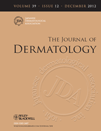Pediatric case report: Clinical profile of a patient with PCWH with p.Q377X nonsense mutation in the SOX10 gene
Abstract
We report the case of a Japanese patient with PCWH, a neurological variant of Waardenburg type 4. Direct sequencing of the genomic DNA obtained from peripheral leukocytes revealed the p.Q377X nonsense mutation in the SOX10 gene. The patient had mottled hypopigmented macules on the trunk since birth; such macules have not been described previously. The so-called “white forelock”, a triangular or diamond shaped leukoderma on the forehead, was absent. We also reviewed and summarized the outcomes of 23 patients with Waardenburg syndrome type 4, PCWH and Yemenite deaf–blind hypopigmentation syndrome, in which SOX10 mutations were identified. Among them, 17 cases were reported to have hypopigmented skin macule(s). The five patients who had the white forelock had PCWH with severe neurological complications. Paradoxically, two cases had hyperpigmented spots. Heterochromia of the iris was reported in four patients.




